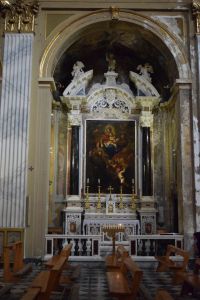The Jesuit Church
The construction of the primitive church in Romanesque style dates back to the second half of the 11th century and the first half of the following century, while in 1142 the sacred building came into the possession of the San Remo community of Benedictines from the Genoese convent of Santo Stefano, who lived in a monastery attached to the church, which in 1210 received the remains of Saint Ampelio.
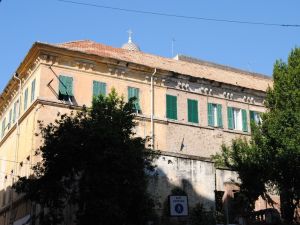
After the archbishop of Genoa Gualtiero da Vezzano had decided to move from Pigna and had a new archiepiscopal palace built in the area of Santo Stefano, the Genoese prelate induced the Benedictine monks to make an exchange in 1258, consisting in the transfer of the Benedictines to the church of San Martino di Via sul Bisagno in Genoa and the transfer of the Matuzian church of Santo Stefano to the Genoese archbishop.
From the 13th century onwards, the church of Santo Stefano also hosted numerous sessions of the city parliament, in which all the men of age of the population participated to decide together on the most important measures to be taken in the interest of the community. In the 15th century, the church was governed by two "massari" who administered its property, while the archbishop of Genoa periodically appointed a chaplain who took care of the religious functions.
In the following centuries, however, the church showed unmistakable signs of structural fragility, so much so that in 1601 the municipal authorities decided to proceed with the complete demolition of the building, which was now unsafe and completely unstable.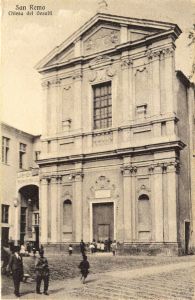 However, after the construction of new walls on the old foundations had begun, it was realised that the complete reconstruction of a new building on the exact site of the old one did not meet the needs of a significantly increased population, which needed a much larger church than the previous one.
However, after the construction of new walls on the old foundations had begun, it was realised that the complete reconstruction of a new building on the exact site of the old one did not meet the needs of a significantly increased population, which needed a much larger church than the previous one.
In 1610 it was therefore decided to demolish the rebuilding walls to the ground, to build new foundations for the façade in order to extend the body of the church forward, and also to extend the width of the building to include the side chapels that protruded outside the perimeter wall.
Once the building area had been extended, construction began, although it soon became apparent that there were insufficient funds available to build the church, so much so that the local authorities had to resort to the "sequella", i.e. the obligation for men and women between the ages of twelve and seventy to work, completely free of charge, to carry out work considered to be of public utility. Around 1611, construction was almost complete, so that after the demolition of the old church, only the choir, or apse, remained standing, but it was unusable at the time because it was cluttered with rubble and various building materials.
 In the meantime the time was ripe for a first group of Jesuit fathers to come to Sanremo, whose arrival was facilitated by the will of the Sanremo priest Alessandro de Bernardi in May 1613, in which the priest made it a condition that they should found a residence in our town with the proceeds of their inheritance. When they arrived in Sanremo in 1616, the Jesuits were immediately interested in setting up a school for the education of the young people of Sanremo, which was temporarily housed in some rooms of an old building near the church of Santo Stefano, while the work on the latter had been blocked for about ten years, so much so that the sacred functions could barely be celebrated on an altar that had not yet collapsed and was closed off by a temporary fence in the presbytery area.
In the meantime the time was ripe for a first group of Jesuit fathers to come to Sanremo, whose arrival was facilitated by the will of the Sanremo priest Alessandro de Bernardi in May 1613, in which the priest made it a condition that they should found a residence in our town with the proceeds of their inheritance. When they arrived in Sanremo in 1616, the Jesuits were immediately interested in setting up a school for the education of the young people of Sanremo, which was temporarily housed in some rooms of an old building near the church of Santo Stefano, while the work on the latter had been blocked for about ten years, so much so that the sacred functions could barely be celebrated on an altar that had not yet collapsed and was closed off by a temporary fence in the presbytery area.
In order to find suitable accommodation for the Jesuits, who were looking for a permanent place to live, Provost Sasso asked that the remains of the old church of Santo Stefano and the area where the new one had just begun be given to them.
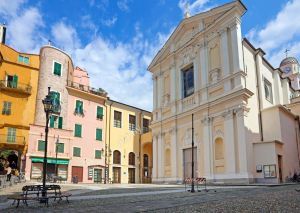 The request was granted on 21 April 1622 for the ecclesiastical part and on 20 February 1623 for the administrative part. Having taken possession of their new premises in March 1623, the Jesuits immediately set about continuing the work on the church, so much so that already in August 1626 they asked the Municipality for permission to demolish the bell tower at their own expense and temporarily relocate the bells to another site in order to rebuild the new one.
The request was granted on 21 April 1622 for the ecclesiastical part and on 20 February 1623 for the administrative part. Having taken possession of their new premises in March 1623, the Jesuits immediately set about continuing the work on the church, so much so that already in August 1626 they asked the Municipality for permission to demolish the bell tower at their own expense and temporarily relocate the bells to another site in order to rebuild the new one.
After a series of successive allocations from the Municipality, decided between 1650 and 1652, work on the new church continued with particular alacrity, so much so that, around 1670, at least the load-bearing structures of the building were finished with the laying of the roof and the completion of the most 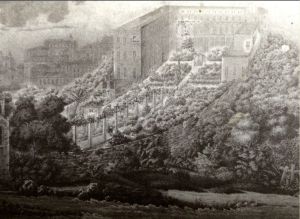 important work on the church, even though the decorations, embroidery and sumptuous ornaments were still missing, which at the time - in the age of the triumphant Baroque - were considered absolutely essential. The ambitious project for the total renovation of the building, pursued with tenacity and determination by the San Remo Jesuits from around 1668 onwards, was perhaps also stimulated by the simultaneous erection, by the architect Pietro Antonio Corradi, of the neighbouring and imposing Turchine monastery.
important work on the church, even though the decorations, embroidery and sumptuous ornaments were still missing, which at the time - in the age of the triumphant Baroque - were considered absolutely essential. The ambitious project for the total renovation of the building, pursued with tenacity and determination by the San Remo Jesuits from around 1668 onwards, was perhaps also stimulated by the simultaneous erection, by the architect Pietro Antonio Corradi, of the neighbouring and imposing Turchine monastery.
On December 7, 1668, the City Council granted the sum of four hundred liras to whitewash the vault, while on February 9, 1669, it was agreed to commission the reverend Gio Batta Aicardi from San Remo to paint the coat of arms of the Community of San Remo on the ceiling of the church.
In July 1671 and in January 1672 five hundred liras were also allocated for the Reverend Antonio Francesco Pesante to go to Genoa to have a copy made of the painting depicting the martyrdom of St. Stephen existing in the homonymous Genoese church.
On 18th September 1671, it was decided to raise the bell tower of the church, which was considered too low for the Baroque taste of the time, with the relevant enlargement works subsidised by two loans granted in September 1677 and March 1678. 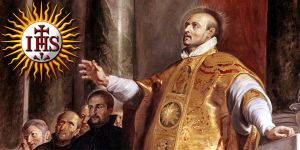 After a series of long and laborious negotiations, on 25 February 1734 the rector Father Mario Torre declared before the municipal authorities that he accepted the convention with which the Municipality of Sanremo formally ceded the church of Santo Stefano to the Jesuit fathers, who, in order to worthily commemorate the event, had a plaque affixed to the façade of the church facing the present-day Piazza Cassini, bearing an inscription in Latin, the Italian translation of which reads as follows: "The Community of Sanremo dedicated this temple, ruined by antiquity and rebuilt more magnificently with its own money, to Saint Stephen the Protomartyr. The Fathers of the Society of Jesus accepted it as a gift from it (Community) and decorated it at their own expense, enlarging it to this extent".
After a series of long and laborious negotiations, on 25 February 1734 the rector Father Mario Torre declared before the municipal authorities that he accepted the convention with which the Municipality of Sanremo formally ceded the church of Santo Stefano to the Jesuit fathers, who, in order to worthily commemorate the event, had a plaque affixed to the façade of the church facing the present-day Piazza Cassini, bearing an inscription in Latin, the Italian translation of which reads as follows: "The Community of Sanremo dedicated this temple, ruined by antiquity and rebuilt more magnificently with its own money, to Saint Stephen the Protomartyr. The Fathers of the Society of Jesus accepted it as a gift from it (Community) and decorated it at their own expense, enlarging it to this extent".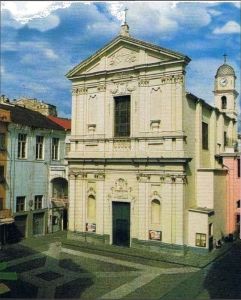 In the same years the scholastic activity carried out in the College next to the church continued apace, which was further enlarged from 15 October 1742 thanks to the financing of the Jesuit Paolo Francesco Negrone, while in 1764 the square in front of the church was paved on the initiative of the rector Father Agostino Galleano of Ventimiglia.
In the same years the scholastic activity carried out in the College next to the church continued apace, which was further enlarged from 15 October 1742 thanks to the financing of the Jesuit Paolo Francesco Negrone, while in 1764 the square in front of the church was paved on the initiative of the rector Father Agostino Galleano of Ventimiglia.
During this period, important new works were carried out inside the church, which was further enlarged with the opening of two new side chapels, one dedicated in 1765 to Our Lady of Hope, and the other, again in the same year and on the initiative of the missionary father Girolamo Durazzo, to Saint Joseph; the latter would later be chosen in the last century to house the throne of Our Lady of the Rosary of Pompei.
Also dating from this period is the arrangement of a series of paintings, one depicting the healing of Palladia, another St Stephen protecting sailors, a third the invention of the relics of St Stephen, which are now on the right-hand wall of the nave, while other paintings relating to the life and works of the church's patron saint were placed on the left-hand wall: the resurrection of a child by St Stephen, the translation of the saint's relics to Rome, the deposition of his body in the tomb located in the church of San Lorenzo in Rome and finally an episode of the saint's preaching, attributable to Francesco Carrega (1706-1780).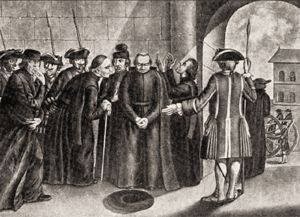
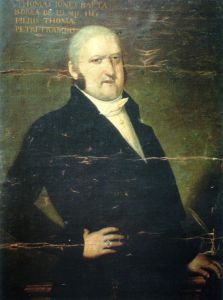 After the suppression of the Society of Jesus with the papal bull of 21 July 1773, the Jesuits of San Remo also had to comply with the papal provisions, while the church of Santo Stefano was entrusted to the priest Paolo Giuseppe Bestoso.
After the suppression of the Society of Jesus with the papal bull of 21 July 1773, the Jesuits of San Remo also had to comply with the papal provisions, while the church of Santo Stefano was entrusted to the priest Paolo Giuseppe Bestoso.
When the Company was officially re-constituted on 7th August 1814, the head of the Council of Elders Tomaso Borea d'Olmo, expressing the feelings of the entire townspeople, proposed that the Jesuits be recalled and that the church of Santo Stefano and the adjoining College be given back to them, with a monetary contribution for the schools. The request was granted on 12 July 1815 with the governmental authorisation for the return of the Jesuits to San Remo.
On 16th August 1816 the deed of transfer to the Jesuits of the college, of the church of Santo Stefano and of all the goods that had been rented by the Marquis Tomaso Borea d'Olmo was signed, even if this deed was not followed by the immediate return of the Jesuits, who returned to the city only in November 1838 thanks also to a bequest by the bishop Giovanni Battista D'Albertis.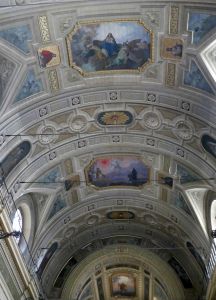 Due to the severe damage caused by the earthquakes of 1818 and 1831, which particularly damaged the vault of the church, the building was repaired, including the marble floor in 1840 and the reinforcement of the vault, which was then painted by Siro Orsi, a painter of the Lombard school. These frescoes were later lost during the restoration work required to repair the damage caused by the subsequent earthquake of 23 February 1887, so that only a few paintings by Orsi remain today behind the high altar. Further embellishment work inside the church was carried out in 1843 with the proceeds of a bequest that the rector, Father Siro Lombardi, had donated to the church.
Due to the severe damage caused by the earthquakes of 1818 and 1831, which particularly damaged the vault of the church, the building was repaired, including the marble floor in 1840 and the reinforcement of the vault, which was then painted by Siro Orsi, a painter of the Lombard school. These frescoes were later lost during the restoration work required to repair the damage caused by the subsequent earthquake of 23 February 1887, so that only a few paintings by Orsi remain today behind the high altar. Further embellishment work inside the church was carried out in 1843 with the proceeds of a bequest that the rector, Father Siro Lombardi, had donated to the church.
Following a series of violent anti-Jesuit demonstrations in March 1848, the Matuzian authorities were forced to order the eviction of the last remaining fathers from the convent. Even without the spiritual guidance of the Jesuits, work continued to establish St Stephen's Church as a parish, which was officially constituted on 22 October 1888.
In the meantime, the solemn dedication of the church and the high altar by the Bishop of Ventimiglia, Lorenzo Biale, had taken place in 1853.
Once the most heated years of the anti-Jesuit campaign had passed, the Jesuit fathers resumed their visits to our town, but it was not until 10 November 1907 that they were able to resume regular religious celebrations in Santo Stefano, and they also took possession of the parish on 1 February 1927. 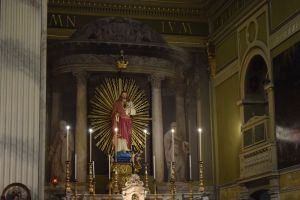 In the meantime, on 22 October 1919, at the request of the Jesuits themselves, the Sacred Congregation of Rites had declared the Sacred Heart of Jesus
In the meantime, on 22 October 1919, at the request of the Jesuits themselves, the Sacred Congregation of Rites had declared the Sacred Heart of Jesus 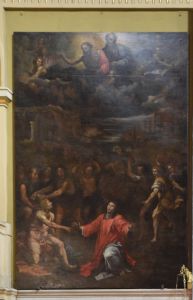 to be co-patron of the parish together with St Stephen's. Following this decree, the large statue of the Sacred Heart was placed above the high altar, while the painting of St Stephen's, which had been there for over two centuries, was hung on the wall to the left of the altar.
to be co-patron of the parish together with St Stephen's. Following this decree, the large statue of the Sacred Heart was placed above the high altar, while the painting of St Stephen's, which had been there for over two centuries, was hung on the wall to the left of the altar.
In the meantime, the last Jesuit properties in San Remo were sold, and the proceeds were used to finance the restoration work, which began in 1927 and was completed in 1933, since the vault of the church still showed damage caused by the earthquake of 1887; during this work, the bell tower was also raised and strengthened. The municipality also contributed to the work with money and technical assistance, especially from the mayor of Sanremo, Pietro Agosti.
On October 31, 1938, the Bishop of Ventimiglia Agostino Rousset, upon request of the Jesuits themselves, transferred the parochial benefice of the church of Santo Stefano to that of Nostra Signora della Mercede, so that even today the church of Santo Stefano does not have parochial functions, remaining however always spiritually administered by the local Jesuit community.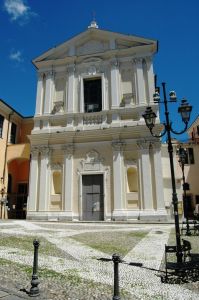
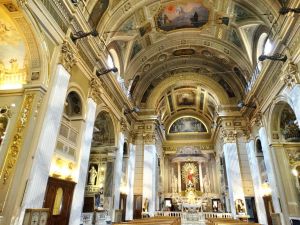 The present building has a single rectangular hall with side chapels alternating with choir stalls, in accordance with an arrangement almost always applied in Jesuit churches, and a presbytery without a choir. The stucco decoration of the interior was carried out in 1679 by the architect and stucco artist Marc'Antonio Grigo.
The present building has a single rectangular hall with side chapels alternating with choir stalls, in accordance with an arrangement almost always applied in Jesuit churches, and a presbytery without a choir. The stucco decoration of the interior was carried out in 1679 by the architect and stucco artist Marc'Antonio Grigo.
The rectilinear façade, built in the first half of the 18th century, has two rows of twin pilasters at the sides, while the upper part, raised above a high pedestal and ending with a triangular pediment, is particularly striking.
The plasticity of the walls is emphasised by the presence of a series of cornices, pilaster strips and mirrors that create suggestive chiaroscuro effects in contrast to the uniformity of the colouring.
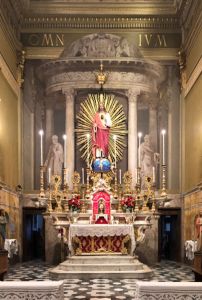 The high altar, perhaps the one donated to the church in 1770 by Giuseppe De Ferrari, is adorned on the left wall by the large altarpiece depicting the stoning of St Stephen (see above), commissioned by the Matucian Town Council, probably in the last thirty years of the 17th century, by an unknown painter, almost certainly from Genoa, who copied it from the painting of the same name by Giulio Romano in 1523 and kept in the church of Santo Stefano in Genoa.
The high altar, perhaps the one donated to the church in 1770 by Giuseppe De Ferrari, is adorned on the left wall by the large altarpiece depicting the stoning of St Stephen (see above), commissioned by the Matucian Town Council, probably in the last thirty years of the 17th century, by an unknown painter, almost certainly from Genoa, who copied it from the painting of the same name by Giulio Romano in 1523 and kept in the church of Santo Stefano in Genoa.
The two side chapels closer to the presbytery were decorated on the initiative of the city's most prestigious private patrons. It was from the proceeds of the sale of the two chapels that the Municipal Council decided in 1680 to use the funds to purchase precious marble to decorate the high altar, where the city's coat of arms would also be placed. Around 1920, the high altar was then largely covered with new marble, while the presbytery was adorned with stucco and gilding.
Around 1920, the high altar was then largely covered with new marble, while the presbytery was adorned with stucco and gilding.
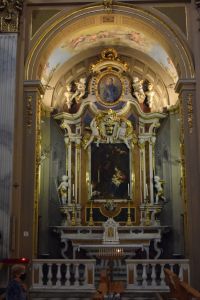
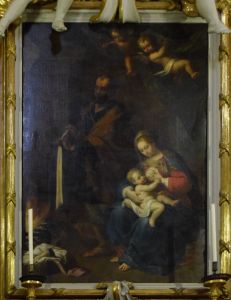
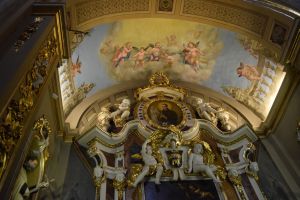 Chapel of the Holy FamilyThe first chapel to the left of the entrance, dedicated to the Holy Family, has an altarpiece consisting of a canvas by Nicolas Mignard (1606-1668) depicting The Holy Family at Home in Egypt,
Chapel of the Holy FamilyThe first chapel to the left of the entrance, dedicated to the Holy Family, has an altarpiece consisting of a canvas by Nicolas Mignard (1606-1668) depicting The Holy Family at Home in Egypt, 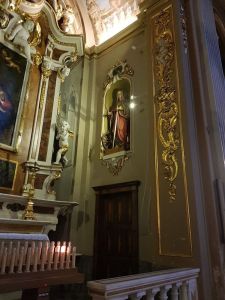 surmounted by an oval representing Saint John Berchmans, a Jesuit student, while the two niches contain statues of Saint Luigi Gonzaga on the left and Saint Catherine of Alexandria on the right.
surmounted by an oval representing Saint John Berchmans, a Jesuit student, while the two niches contain statues of Saint Luigi Gonzaga on the left and Saint Catherine of Alexandria on the right.
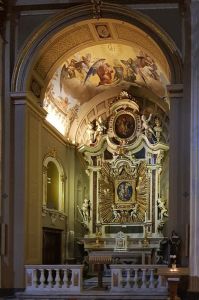
![]() The first cha
The first cha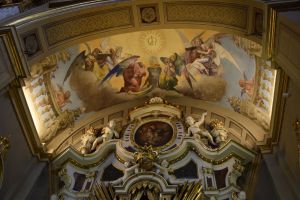 pel on the right, dedicated to Our Lady of Hope, has an artistic altarpiece depicting the titular Madonna, considered to be the protector of seafarers, surmounted by an oval with Saint Stanislaus Kostka, a Jesuit novice, while the vault is frescoed with adoring angels. The two niches contain statues of St Joseph on the left and St Teresa of Avila on the right.
pel on the right, dedicated to Our Lady of Hope, has an artistic altarpiece depicting the titular Madonna, considered to be the protector of seafarers, surmounted by an oval with Saint Stanislaus Kostka, a Jesuit novice, while the vault is frescoed with adoring angels. The two niches contain statues of St Joseph on the left and St Teresa of Avila on the right.
The second chapel on the right side was purchased in 1679 by the Sanremo nobleman Paolo Battista Palmari with the obligation of its arrangement and completion within four years, the right to use it as his family's burial place and the commitment to cover it entirely in marble and dedicate it to Saint Francis Xavier.
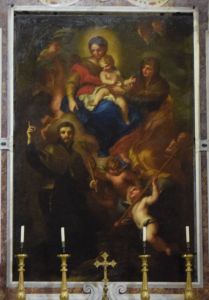 For the seventeenth-century marble altar of the chapel, Palmari commissioned a canvas by the most famous and successful Genoese painter of the time, Domenico Piola (1627-1703), who produced a very significant work that reflects a taste as refined as it is restrained, depicting the Madonna, Child, St Francis Xavier and St Anne, in which the contribution of the master's son, Anton Maria, is also evident. The vault of the chapel is frescoed with the image of St Francis Xavier in Glory; on the right-hand wall, on the other hand, the Madonna and St Joseph carrying the Child to St Anne are depicted, while St Francis Xavier on the island of Sanciano is depicted.
For the seventeenth-century marble altar of the chapel, Palmari commissioned a canvas by the most famous and successful Genoese painter of the time, Domenico Piola (1627-1703), who produced a very significant work that reflects a taste as refined as it is restrained, depicting the Madonna, Child, St Francis Xavier and St Anne, in which the contribution of the master's son, Anton Maria, is also evident. The vault of the chapel is frescoed with the image of St Francis Xavier in Glory; on the right-hand wall, on the other hand, the Madonna and St Joseph carrying the Child to St Anne are depicted, while St Francis Xavier on the island of Sanciano is depicted.
In the niches of the chapel are the statues of the Immaculate Conception on the right and St Stephen the Martyr on the left.
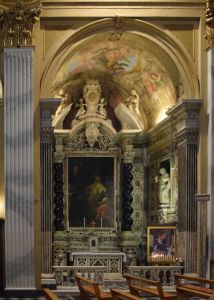 In the chapel opposite, on the left-hand side, purchased in 1680 by the Marquis Borea d'Olmo, dedicated to St Ignatius of Loyola and richly inlaid with marble, the vault painted around 1695 with the Glory of St Ignatius by the Genoese painter and engraver Giovanni Battista Merano (c. 1632 - 1698) is
In the chapel opposite, on the left-hand side, purchased in 1680 by the Marquis Borea d'Olmo, dedicated to St Ignatius of Loyola and richly inlaid with marble, the vault painted around 1695 with the Glory of St Ignatius by the Genoese painter and engraver Giovanni Battista Merano (c. 1632 - 1698) is 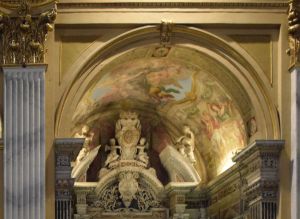 particularly noteworthy.
particularly noteworthy.
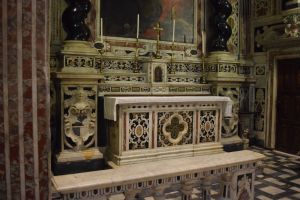 The Baroque altar in marble marquetry with twisted columns, the space around which is refaced with artistic marble marquetry mirrors, still inspired by the 16th century, with statues of St John the Baptist and St John the Evangelist, while the vaults of the chapel were frescoed by Francesco Carrega.
The Baroque altar in marble marquetry with twisted columns, the space around which is refaced with artistic marble marquetry mirrors, still inspired by the 16th century, with statues of St John the Baptist and St John the Evangelist, while the vaults of the chapel were frescoed by Francesco Carrega.
The work on the altar, completed in 1693, was also entrusted to Lombard-Genovese workers.
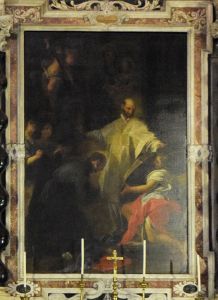 The complex also acquires particular charm from the placement above the altar of the prestigious altarpiece by Andrea Pozzo (1642-1709), a notable Jesuit perspective painter, painted between 1669 and 1671 before the great decorative cycle of the Church of the Mission in Mondovì, and depicting Saint Ignatius dressing Saint Francis Borgia in the Jesuit habit.
The complex also acquires particular charm from the placement above the altar of the prestigious altarpiece by Andrea Pozzo (1642-1709), a notable Jesuit perspective painter, painted between 1669 and 1671 before the great decorative cycle of the Church of the Mission in Mondovì, and depicting Saint Ignatius dressing Saint Francis Borgia in the Jesuit habit.
There are also traces of a Renaissance perspective fresco behind the high altar.
In the sacristy there is a 17th-century painting of the Madonna del Latte.
Lastly, the presbytery houses a painting that must have been the church's main painting from 1672.
(source elaborated from text by A.Gandolfo; personal and archive images)





